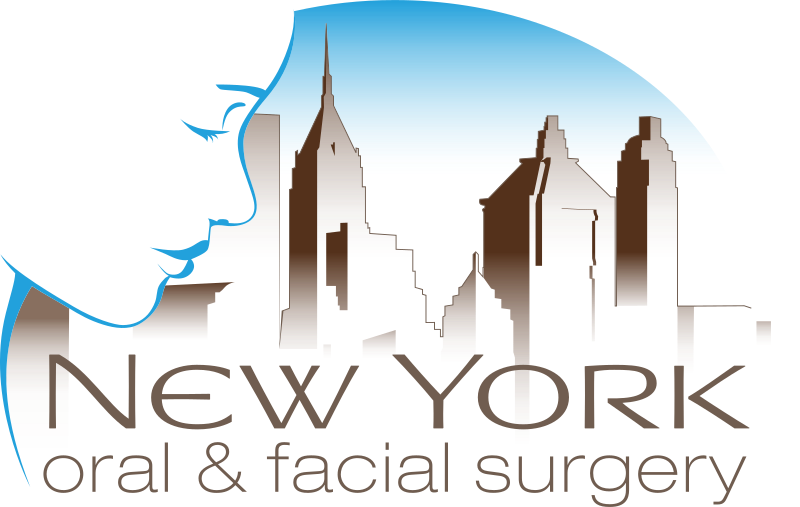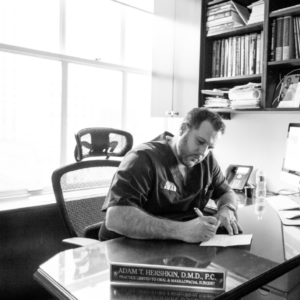WHAT IS TMJ?
TMJ stands for temporomandibular joint, or the jaw joint. In fact, you have two of them. It is made up of the condylar process of the mandible (lower jaw) and the glenoid fossa of the temporal bone (part of the skull base). If you place your fingers just in front of your ears and open your mouth, you can feel the mandibular condyle moving in the joint. These are complex joints that are capable of both hinging and sliding movements. In addition, there is a meniscus (cartilage disc) that lies between the two bones and is meant to move with the condyle of the mandible. The bones and the meniscus are covered with fibrocartilage, a type of cartilage that is not meant to bear weight or to withstand compressive forces.
WHAT IS TMD?
TMD stands for temporomandibular disorders and encompasses a range of facial pain/dysfunction conditions that include intra-articular (inside the joint) and muscular problems. One of the major problems with TMD is that there is still no consensus on the cause, how to prevent, or how to treat these disorders. Fortunately though, if we pay heed to the quality scientific evidence that is available to us, we can treat these problems successfully. For most patients, the problem is nothing more than a strained/sprained joint. While most practitioners view TMD as a predominantly dental problem, the truth is that the TMJ is a joint, much like an ankle, a knee or a shoulder and should be diagnosed and treated as such. For patients with acute injuries, resting the joint and performing simple, conservative treatment will resolve the problem in a short period of time. For others the problem is chronic and requires more advanced treatment modalities. Because the TMJ complex is made up of living bone, ligaments and muscles, it is capable of repair, adaptation and healing.
WHAT ARE THE SYMPTOMS?
- Pain in front of the ears (during opening, closing, chewing)
- Clicking, popping, grinding, swooshing noises in the joints
- Jaw locking closed or open
- Pain or fatigue in the chewing muscles
- Headaches
- Earaches
- Tinnitus (ringing in the ears)
- Changes in occlusion (teeth not hitting correctly)
WHAT ARE THE CAUSES?
- Overt trauma to the joint apparatus
- Blow to the jaw
- Whiplash
- Chronic overloading of the joint
- Bruxism (grinding of the teeth)
- Clenching
- Abnormal movements
- Sprain of the joint
- Ligament laxity (loose joints)
- Systemic disease
- Connective tissue disease
- Rheumatoid arthritis
- Fibromyalgia
- Cervical spine factors
- Degenerative disease of the neck
- Abnormal posture
It is very important to understand that many patients do not fit neatly into one of these categories, but rather are suffering from a combination of factors that contribute to their overall facial pain. For many people, symptoms seem to start without obvious reasons. Like osteoarthritis of other joints in the body, doctors do not know the causes. True scientific research disproves the popular belief in the dental community that malocclusion (bad bite) or orthodontics (braces) causes TMDs. TMD is an orthopedic problem and usually not a dental problem.
HOW IS TMD DIAGNOSED?
As with causes and treatments, there is no widely accepted standard for diagnostic testing. The gold standard for disease detection in TMD patients is an in depth clinical examination by a skilled practitioner. Radiographic examination (x-ray) is often indicated as well. There are many high-tech gizmos available for acquiring additional diagnostic information but they are not necessary based upon the scientific evidence that is available at this time.

WHAT ARE THE DIAGNOSES OF TMD?
Muscular Disorders
- Strain: over-stretching of tissue
- Sprain: rupture of fibers continuity remains intact
- Myositis: inflammation of muscles & attached connective tissue damage occurs in contractile fibers
- Splinting: protective rigidity guarding against painful movement causes muscle tenderness to palpation
- Fatigue: may be significant factor in inducing pain
- Tenderness: Implies damaged muscle fibers
- Hyperactivity: caused by emotional stress, leading to pain-dysfunction cycle
- Myofascial pain: Hallmark of many generalized muscle pain syndromes
- Trigger points: localized hyper-irritable foci
Joint Disorders
- Synovitis: inflammation of a synovial membrane, which line those joints which possess cavities, namely synovial joints. The condition is usually painful, particularly when the joint is moved. The joint usually swells due to fluid collection.
- Effusion: an abnormal collection of fluid in a body cavity or space
- Osteoarthritis: disease of cartilage and bone; aka degenerative joint disease
- Rheumatoid arthritis: inflammatory systemic synovitis
- Internal Derangement: disruption of the functioning of the ligaments and cartilage of a joint
- Hyper-mobile Joint: laxity of ligaments or certain bony anatomy that predisposes to patients dislocating TMJs (open lock)
HOW ARE TMDs TREATED?
Treatment varies and may be different for each patient. Your treatment plan and care will be customized and tailored to your specific needs and diagnosis. Treatment options range from simple self-care to custom total joint replacement. Because, for most patients, TMD symptoms are usually self-limiting, simple, conservative modalities are used as first line treatments.
It is important to understand that TMD is a musculoskeletal disorder as opposed to a dental disorder and the teeth have little to do with it. Dr. Hershkin is an expert in treating these ailments using evidence-based research and he uses tried and true methods to treat this joint exactly as the orthopedic community treats the other joints in the body. Patients who suffer from chronic pain are treated exactly as other chronic pain patients are treated.
Part of your initial appointment will involve your doctor formulating a special, individualized treatment plan that is tailor-made just for you. Dr. Hershkin will offer you treatment options drawn from his experience and knowledge base that he feels may have a positive effect on your symptoms. Dr. Hershkin is skilled in all phases of treatment for diseased TMJs, from the simplest conservative treatment to the most complex surgical procedures. He uses all available scientific research to pick and choose the newest and most successful procedures to offer to his patients to ease their suffering.


